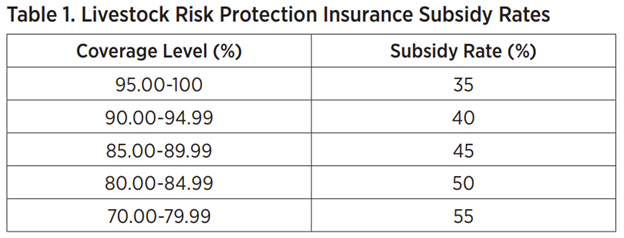Navigating Business Risks with Bagley Risk Management
Navigating Business Risks with Bagley Risk Management
Blog Article
Key Elements to Think About When Deciding On Animals Danger Protection (LRP) Insurance Policy
When examining options for Livestock Risk Defense (LRP) insurance, a number of crucial variables call for mindful factor to consider to ensure effective risk management in the agricultural market. Selecting the ideal protection choices tailored to your specific animals procedure is paramount, as is understanding how exceptional expenses correlate with the level of defense used. Additionally, the eligibility criteria for various kinds of livestock and the versatility of the policy to adjust to transforming conditions are crucial components to evaluate. The effectiveness and openness of the insurance claims procedure can substantially impact the total experience and monetary outcomes for animals producers. By strategically browsing these important elements, manufacturers can protect their financial investments and reduce potential dangers successfully.
Insurance Coverage Options
When thinking about Animals Threat Protection (LRP) insurance coverage, it is important to understand the different insurance coverage alternatives available to mitigate dangers in the farming field. Livestock Danger Security (LRP) insurance policy supplies different protection choices customized to fulfill the varied demands of animals manufacturers. Bagley Risk Management. Among the main insurance coverage alternatives is price coverage, which safeguards against a decline in market costs. Manufacturers can choose the insurance coverage degree that aligns with their price risk administration goals, enabling them to secure their procedures versus prospective monetary losses.
Another essential protection choice is the recommendation duration, which figures out the length of time the coverage holds. Manufacturers can choose the recommendation period that best matches their production cycle and market conditions. In addition, protection levels and prices vary based upon the type of livestock being guaranteed, giving manufacturers the versatility to tailor their insurance coverage prepares according to their specific demands.
Comprehending the various coverage options readily available under Livestock Danger Security (LRP) insurance coverage is important for manufacturers to make informed decisions that successfully shield their animals procedures from market uncertainties.
Costs Costs

Livestock Danger Defense (LRP) insurance policy gives crucial insurance coverage choices tailored to minimize dangers in the farming field, with a substantial element to think about being the calculation and framework of premium costs. These consist of the kind and number of livestock being guaranteed, the insurance coverage level chosen, the existing market costs, historical rate data, and the size of the insurance coverage duration.
Premium expenses for LRP insurance are typically computed based on actuarial information and run the risk of assessment versions. Insurance companies analyze historic data on animals costs and production prices to identify an ideal premium that mirrors the level of threat included. It is essential for animals manufacturers to thoroughly evaluate premium expenses and insurance coverage choices to guarantee they are effectively protected versus potential monetary losses as a result of unfavorable market problems or unexpected occasions. By recognizing exactly how exceptional prices are calculated and structured, manufacturers can make enlightened decisions when choosing the appropriate LRP insurance coverage for their procedure.
Eligible Livestock
The resolution of qualified livestock for Livestock Threat Defense (LRP) his comment is here insurance coverage entails cautious consideration of particular requirements and characteristics. Animals kinds that are normally qualified for LRP insurance coverage include feeder livestock, fed swine, cattle, and lambs.
Feeder cattle, for example, are generally qualified for LRP coverage if they drop within defined weight ranges. Fed livestock may also be qualified, but they must satisfy specific weight and top quality grade demands. Swine eligible for coverage normally include market weight pets intended for massacre. Lambs are another category of animals that can be considered for LRP insurance coverage, with elements such as weight and age playing an important role in identifying their qualification.
Prior to selecting LRP insurance coverage for animals, manufacturers should carefully assess the qualification criteria laid out by the insurance provider to ensure their animals meet the required demands for insurance coverage.
Policy Flexibility
Policy versatility in Animals Danger Defense (LRP) insurance permits manufacturers to tailor coverage to fit their certain requirements and run the risk of management methods. This adaptability encourages animals manufacturers to customize their insurance coverage based on factors such as the sort of livestock they own, market problems, and specific threat resistance degrees. One key facet of policy flexibility in LRP insurance coverage is the capability to select protection levels that line up with the manufacturer's economic objectives and run the risk of exposure. Producers can select coverage degrees that shield them against possible losses as a result of variations in animals costs, ensuring they are effectively insured without overpaying for unneeded insurance coverage. In addition, LRP insurance policy uses versatility in policy period, enabling producers to pick protection periods that best fit their manufacturing cycles and advertising and marketing timelines. By supplying adjustable options, LRP insurance policy makes it possible for producers to efficiently handle their threat direct exposure while protecting their animals procedures against unpredicted market volatility.
Insurance Claims Refine
Upon experiencing a loss or damage, manufacturers can launch the claims process for their Animals Threat Defense (LRP) insurance by immediately calling their insurance policy supplier. It is crucial for producers to report the loss asap to expedite the insurance claims procedure. When connecting to the insurance policy supplier, manufacturers will require to supply detailed information regarding the occurrence, consisting of the day, nature of the loss, and any relevant documentation such as veterinary records or market costs.

After the assessment is complete, the insurance coverage service provider will certainly make a decision concerning the case and communicate the end result to the producer. The manufacturer will certainly receive settlement according to the terms of their Livestock Danger Defense (LRP) insurance coverage policy if the insurance claim is accepted. It is important for manufacturers to be acquainted with the claims process to guarantee a smooth experience in case of a loss

Conclusion
In final thought, when choosing Livestock Risk Protection (LRP) insurance coverage, it is necessary to take into consideration insurance coverage alternatives, premium expenses, eligible livestock, plan flexibility, and the cases procedure. These crucial aspects will assist guarantee that ranchers and farmers are properly protected versus possible dangers and losses connected with their livestock procedures. Making a notified decision based on these considerations can inevitably cause much better financial security and comfort for livestock producers.
Animals Danger Protection (LRP) insurance policy uses various insurance coverage choices customized to satisfy the diverse demands of livestock manufacturers.The decision of eligible animals for Livestock Threat Security (LRP) insurance protection involves mindful consideration of details requirements and characteristics.Plan flexibility in Animals Risk Defense (LRP) insurance coverage permits manufacturers to customize protection to suit their specific requirements and risk administration methods.Upon experiencing a loss or damages, producers can start the cases process for their Animals Threat Security (LRP) insurance policy by quickly calling their insurance coverage copyright.In verdict, when picking Animals Risk Protection (LRP) insurance, it is crucial to consider insurance coverage alternatives, premium expenses, eligible livestock, policy versatility, and the insurance claims procedure.
Report this page